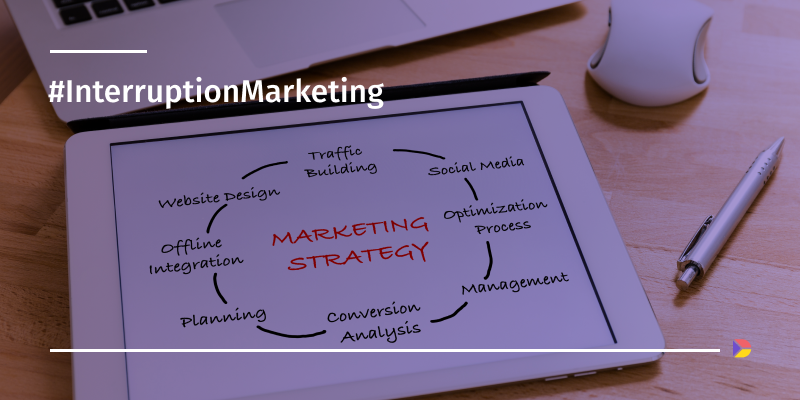Ready to improve your marketing ROI?
Fast registration. User-friendly interface. Robust integrations.
The possibilities of pay-per-call campaigns allow marketers to learn more about their target audience and raise conversions without being interruptive.
Advertising is annoying. Some years ago, people felt irritated as they had to watch a washing powder commercial during their favorite evening show. On the other hand, how could a potential customer know they needed that powder? Today, the situation has changed luckily. We all wish to be savvy about our purchasing habits and the things we eat and wear. The same is true of the information we consume online. Ad blockers and acceptable ads tools are widely used to control what kind of information people wish to see on the screens of their devices. The tendency leads to certain challenges for interruption marketing. Let’s get deeper into the subject and learn about the future of interruption marketing.
What is interruption marketing?
Interruption marketing entails displaying advertisements to the target market while they are engaged in another activity on the internet. In other words, marketers interrupt customers’ routines with their offers. Remember the last time you read that lasagna recipe when a pop-up with a new IT course jumped up on you? That was an example of interruption marketing, often known as outbound marketing.
This way of offering people a product or service implies an immediate reaction. As a rule, the target audience has never seen the product before; that is why pop-up ads are similar to cold calling. Those who feel interested click on the ad, which leads to increased brand recognition even if no further conversion occurs.
The opposite method is inbound marketing, or permission marketing. Seth Godin popularized the term in 1999. Mr. Godin found out that the success of marketing campaigns depends on whether a customer wants to learn information about the product or service. That is to first ask if a person would like to see the ad. In such a situation, the intention to learn more about the product comes from the customer and is not imposed on them by the marketer. That is why it is called inbound.
- Cold calls
- TV and radio ads
- Outdoor advertising
- Printed handouts
- Pop-ups and banners
- Direct texting
- Direct mail
- SEO
- Social media influencers
- Content creation
- Brand image
- Blogging
- Email newsletters
What about social media ads and paid ads? - you may ask.
The days of using social media platforms solely for conversing with friends and sharing family photos are long gone. Businesses today successfully use social media to gather specific audiences and promote products.
Therefore, when a customer searches for a product or service on Google and later sees that product on Instagram, that may be called permission marketing, as the customer actually asked about that product. On the other hand, looking for something on one platform doesn’t mean I wish to stumble at that information over and over again on other platforms. It may seem really annoying sometimes.
As for the paid ads, they do appear upon the exact request of a customer. These may, however, divert the customer's attention away from the organic outcomes they seek.
The solution is always somewhere in between. Taking use of the benefits of both interruption and permission marketing may appear to be a sound plan.
Which type of marketing is better?
All forms of marketing bring certain results when used smartly. Interruption marketing has the following distinctive features:
Pros:
- Rapid outcomes: Masses of potential customers see the ad, which increases the chances of high sales.
- Brand awareness: Wide coverage ensures that more people will know about the product.
Cons:
- Pricey ads: Advertising campaigns blow away the budget, especially when they do not generate enough leads.
- Poor targeting: Interruption marketing aims at grabbing everyone’s attention without segmenting potential customers.
- Attention loss: A typical internet surfer faces dozens of ads daily, making it easy to lose focus.
- Expiry date: Ads are run for a definite period of time. When the time is out, marketers have to start all over again.
Permission marketing implies other challenges and advantages:
Pros:
- Careful targeting: Advertisers specify the target market by creating lookalike audiences.
- Value for money: Demonstrating a product to those who are likely to buy it pays off.
- Brand image: When you support a product with useful content in the blog or send important information in newsletters to the clients, they stay loyal and eventually make subsequent purchases or referrals.
Cons:
- Time - consuming. Building a brand image and gathering loyal customers requires a lot of resources. Businesses should take their time to create a reputation.
It seems that the better option is obvious, right? However, a combination of methods always brings greater outcomes than just one of them. Companies may start attracting audiences and gaining brand awareness with interruption marketing before gradually dismissing it in favor of organic traffic, content creation, and branding.
How can pay-per-call help in planning a marketing strategy?
The pay-per-call model of advertising can significantly assist in gathering valuable information about the target market and therefore improve the performance of campaigns and increase sales. How is that possible?
- You can create several advertising campaigns and, with the help of the DNI system, monitor their performance. After some time, you analyze the results of the campaigns and select the most productive traffic channels. Concentrating precisely on those channels will save a considerable part of the budget.
- Analytical data about the inbound calls provides you with crucial information about the potential customers. As a result, it is possible to create a detailed customer profile and design separate marketing funnels to cover the whole target market. Your customers will appreciate such a personalized approach, which will increase sales.
- Call recordings enable you to fish out the keywords for future ads. Besides, customers may mention their expectations from your service, provide feedback, and inspire further product development. It is possible to skyrocket your customer satisfaction level due to active listening skills.
Conclusion
By incorporating solely interruption marketing into your promotion strategy, you risk losing much money and failing to create a reliable brand image. Consumers' purchasing habits are growing more selective and sophisticated. However, when applied wisely and combined with other techniques, outbound marketing is likely to bring some great results.
Create useful content, show your expertise to the target audience, and organic traffic will show your business is a reliable one. As with any other sphere of life, it is important to stay focused and feel the tendencies and trends of the market. Pay-per-call advertising can become a handy assistant in those processes.
If you are interested in the possibilities of PPC for your business, please contact our team.
Ready to improve your marketing ROI?
Fast registration. User-friendly interface. Robust integrations.
Recently viewed posts
Related posts




